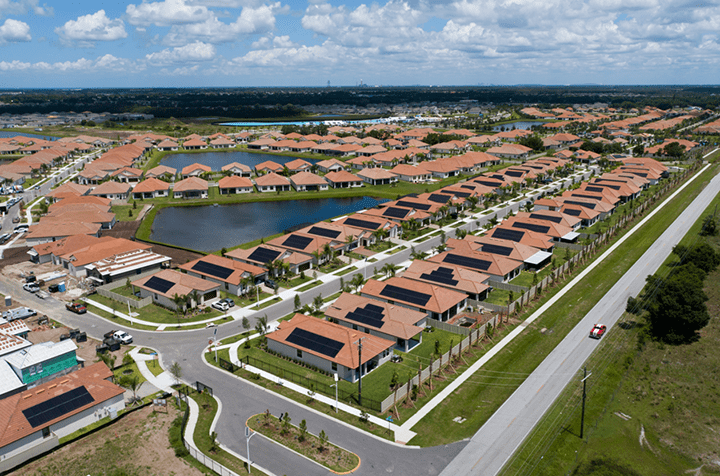It’s no secret – the world of energy is changing rapidly. The trend of relying more extensively on distributed generation, energy storage, EVs and forms of customer load management, such as demand response, to keep power flowing and in balance has only increased in an age of peak demand challenges and increasingly extreme weather.
In fact, according to Guidehouse Insights, more capacity from distributed energy resources (DER) became available globally in 2021 than centralized generation capacity.
While early DER technologies were notably on the customers’ side of the meter, essentially islanding off from the larger utility grid, the tide is turning toward traditional energy companies leveraging the benefits of microgrids and energy storage as key to enabling a more sustainable and resilient energy future. This path forward combines fresh technology approaches with a sound financial strategy to address the primary unmet need of today’s microgrid market in North America: The desire of new residential communities to have a more sustainable and resilient energy system that can be deployed and operated by their trusted host utility.
Utilities are best positioned to deploy DER assets that are strategically integrated into the existing grid and the long-term network system upgrades in a manner that addresses the technical complexities of grid planning and maintains the lowest long-term cost for all customers. They are also a solution to bring energy justice to underserved and minority communities that otherwise may not have the resources for rooftop solar, battery storage or EV charging networks. Microgrids based on these DER technologies are being installed today at college campuses, commercial and industrial facilities, and even military bases.
Power surety is critical to a military base’s mission, and developing methods of greater power resiliency is paramount to on-base security and the mission for the greater U.S. military, which is why the U.S. Department of Defense (DOD) has committed to implementing resilient power solutions and has set major renewable energy goals.
One example of how the DOD has accomplished both goals is at Kirtland Air Force Base (KAFB), the fifth largest such base in the country. Working the Department of Energy’s Distributed Energy Technology Lab, (DETL) and Sandia National Laboratories, (SNL) – a U.S. Department of Energy advanced research facility – Emera Technologies established the first BlockEnergy™ microgrid on KAFB in 2019, which meshed a network of cyber secure, resilient microgrids with renewable, onsite generation. Through the partnership, Emera utilized rooftop solar, battery storage and smart, distributed controls, creating a first-of-its-kind, practical approach to energy surety and resiliency. After energizing BlockEnergy almost three years ago at KAFB, the system has performed effortlessly without any power interruptions.
Yet, even with successes, proposed microgrids by utilities have still been rejected by regulators, primarily over concerns whether the benefits of any single microgrid will flow to all ratepayers, not just a select few. Microgrid advocates publicly denounce existing prohibitions on transferring electricity over public rights-of-way or in “over the fence” transactions with their neighbors. This is because these advocates are narrowly focused on microgrids developed by non-utility third parties.
The beauty of a microgrid is that it can be customized to meet the precise resiliency, economic and environmental goals of any customer, as each microgrid is different from others. Each is a personalized energy system of any size, made up of any available distributed energy resources (DER). Although this ability to customize is one of microgrid’s strongest selling points, the downsides include time and money.
An alternative approach is to provide a modular microgrid design that is inherently more scalable, thereby shrinking design and deployment costs and providing ease of repeatability. This approach is more attractive to financiers, as it creates portfolios of similar assets, but this modular technology is only part of the solution.
The key to enabling technology for a more sustainable and resilient energy future is direct current (DC). Our buildings are increasingly becoming DC-centric with LED lighting and other IT devices. With power outages increasing due to global climate change, extreme weather and increased penetration of DC energy resources not being integrated into the grid intelligently, the question begging for an answer is this: How can utilities work with customers, regulators and government to support the highest levels of clean, reliable DER asset deployment at the lowest cost for everyone?
The whole world is developing plans to get to net-zero carbon emissions, but it is abundantly clear this goal will not be reached without utilities. If indeed utilities take responsibility for the development of DER systems that can evolve into microgrids or related concepts, it can result in:
1. A technology agnostic platform that can foster a step-change increase in sustainable energy resources;
2. advanced reliability and security across all stakeholders due to ownership and design structure;
3. and distributed digital platforms that are adaptable and can accommodate future load growth (and corresponding need for generation and energy storage). This allows for organic and evolutionary growth of the system without losing any functionality or an increase in emissions.
Overall, microgrids provide a combination of benefits and cost avoidance for a more cost-effective alternative to serve new customers at the grid edge. While they are connected to the grid, they do not burden the grid and can provide support to the grid, if chosen by the utility. This is where microgrids can provide resiliency when needed, but also support communities and the larger grid network, if needed.
Utilities can and should take the lead in the march toward a new energy model focused on balancing decarbonization, resiliency, cost to serve and equity stakeholder goals. Meeting all of these objectives is not easy, but there are existing and advancing technology solutions that offer promising answers to the challenges facing an energy system undergoing rapid and transformative change – answers that utilities are in the best position to tackle.
Headline photo: Southshore Bay community in Tampa running on a solar microgrid. Source: Emera Technologies
As vice president of sales and commercial development at Emera Technologies, Bobbi Dillow-Walsh leads the go-to-market strategy and execution to enable decentralized clean energy production and consumption for our transitioning energy market with regard to new residential energy development models and regulatory framework.
With more than 20 years in the energy sector, her global perspective and entrepreneurial spirit have led Dillow-Walsh to be recognized for her work with many first-of-their-kind projects and solutions designed for resilient and sustainable energy. She leads with a focus on creating strong partnerships and collaboration that deliver economic value and advance safe, clean energy.
Dillow-Walsh is a graduate of the Virginia Tech Pamplin College of Business and has an MBA from King University.



